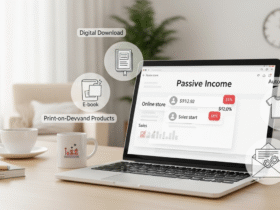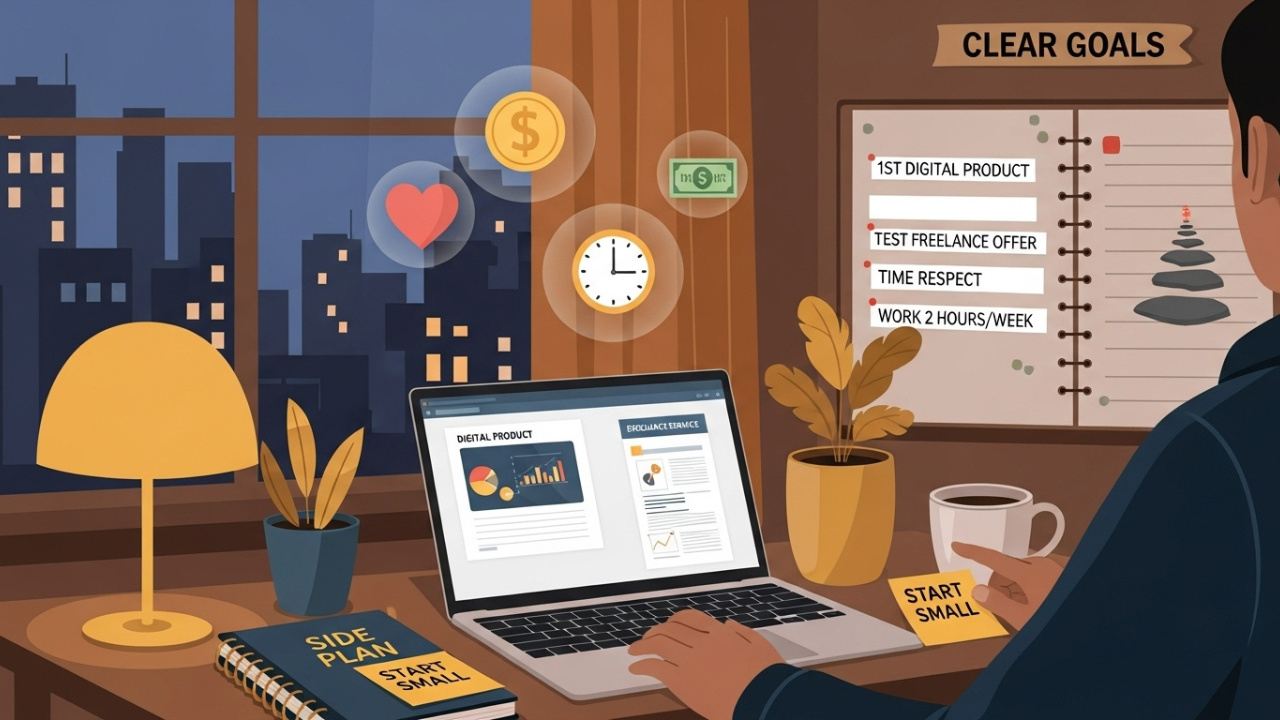You ever find yourself staring at your paycheck and wondering, “Is this it?” You’re not alone. If you’re like most people I’ve talked to, you’re not looking to get rich overnight. You’re just looking for a way to stop trading every hour of your life for a dollar. That’s where passive income steps in—not as some magic fix, but as a tool that helps money work while you sleep, think, or sip coffee on a slow Saturday.
I know this can sound like something meant for finance experts or people who already have money. But it’s not. You, my friend, can start building passive income—even if you’re just figuring things out. I’ll walk you through it like I would explain it to someone I care about. No fluff. No confusing talk. Just real help you can actually use.
What Passive Income Really Means (And Doesn’t Mean)
Let’s clear this up right away. Passive income isn’t some trick that magically fills your bank account. It’s money that comes in regularly after an initial setup. That setup might take time, money, or effort—but the goal is to make it as hands-off as possible after that.
Think about rental income. Or a savings account that gives you interest. Or shares that send you a small check every few months. That’s passive income. It’s not about getting rich quick. It’s about building something small now that grows into something big later.
And yes, it can absolutely be for beginners. Even if you’re starting from zero.
Why You Should Care (Even If You’re Not “Into Investing”)
You don’t need to be a financial nerd to care about passive income. Here’s why it matters. Most people rely on one paycheck. If that disappears, stress follows. Passive income gives you a safety net. It gives you choice. It gives you breathing room.
Maybe you’re tired of worrying about bills. Maybe you just want to spend more time with your family without feeling guilty. Or maybe you want to retire early—or simply retire comfortably. Whatever the reason, passive income makes space for the life you want.
Starting Small Is Not Just Okay—It’s Smart
I know people think you need thousands to get started. Truth is, even small moves matter. You can begin with $50, $100, or $500. The point isn’t how much—it’s that you start. I’ve seen people turn tiny investments into meaningful monthly income over time just by being consistent and patient.
The earlier you start, the better. Not because you’ll make a fortune overnight, but because time helps money grow. And that’s the real power: giving your money the time to quietly build a future behind the scenes.
A Simple Way to Think About Strategy
Here’s the easiest way I’ve found to think about investing for passive income. You want something low-effort, low-stress, and reasonably safe. The goal is income you can count on—not wild bets.
So you look for things that:
-
Pay you regularly
-
Don’t require daily effort
-
Fit your budget and comfort level
That might be as rudimentary as high-yield savings account. Or it could be a little more practical, such as dividend-paying stocks or rent property. It is however important to align the strategy to the present state.
The First Door Most Beginners Walk Through
Let’s say you’ve got a little money saved. Maybe $500. Maybe $1000. The easiest move is usually a high-interest savings account or a Certificate of Deposit (CD). These won’t make you rich. But they give you predictable income with very low risk.
Think of this like your “training wheels” investment. You start here not for big returns, but to build the habit. And that habit is more valuable than the interest itself.
Now let’s say you’re feeling ready for more. That’s where the real fun begins.
When You’re Ready to Grow: Your Next Step
This is where you might explore dividend-paying stocks or Real Estate Investment Trusts (REITs). Sounds fancy, but they’re not. You can buy them right from your phone using beginner-friendly apps. What they do is send you money on a regular schedule, just for owning them.
It’s like renting out your money. And if you choose wisely, it can be one of the best long-term passive income streams around. You don’t need to be a market expert. Just start small, stick with companies or funds that have a good record, and reinvest your earnings until they build up.
Real Estate Without the Headaches
Maybe you’ve heard people say real estate is the key to passive income. And it can be—but not everyone wants to deal with leaky pipes or noisy tenants. That’s why REITs are great. You invest in property through the stock market, and the trust handles all the work. You get a share of the profits. No fixing toilets required.
It gives you access to real estate income without needing a lot of cash or stress. And that makes it one of the best beginner paths if you’re curious about property but not ready to be a landlord.
What About the “New” Stuff Like Apps and Peer Lending?
You’ve probably seen ads for investing apps that do all the work for you. They’re called robo-advisors, and yes, they’re real. These tools help you put your money into income-generating funds based on your comfort with risk. It’s smart, simple, and automatic.
There’s also peer-to-peer lending, where you lend your money to other people and earn interest. It sounds risky—and sometimes it can be. But done carefully, it’s another way to make your savings grow.
The point is, these new tools make it easier than ever to start. You don’t need to read stock charts or study finance. You just need to take the first step.
Mistakes I’ve Seen Beginners Make (And How You Can Avoid Them)
I’ve helped a lot of people get started, and I’ve seen a few patterns. Some try to invest in things they don’t understand. Others dump all their savings into one thing and hope it explodes. Some chase shiny trends and ignore the boring stuff that actually works.
The most intelligent thing to do would be to make it uncomplicated. So do not keep all your eggs in one basket. And you don t want magic. Allow your investments their time. Don t look at the newest thing that is popular but settle down and find things that have been working for the past few years.
In every case you are unsure, back up. Read more. Ask a person whom you trust. and keep in mind risk is permissible..
How to Build a Plan You Can Stick With
Let’s say you’ve decided to try dividend stocks or invest in a REIT. Great. Now what? Here’s how to make it part of your life. Set a fixed amount to invest each month, even if it’s small. Automate it. Track what you earn every quarter. And make a choice: reinvest that income or save it for future use.
Don’t overthink it. Just repeat it.
What starts small adds up fast if you stay consistent. This is how people build wealth slowly, quietly, and without gambling everything on luck.
Tools That Actually Help (No Hype, Just Useful)
You don’t need fancy gear to get started. But it helps to have a few tools. Look for apps that let you invest automatically. Choose one that shows you your earnings clearly. Instead of having to conduct a complicated analysis using a complicated software, use a simple budgeting app to determine the amount you should be investing per month without putting yourself at risk.
Such devices do not give decisions to make. They make it easier to keep on track however.
And when you see your income growing—even by a few dollars—it builds momentum. That’s how passive income becomes a habit, not just a hope.
Be Real About What to Expect
Let’s be honest. You won’t retire in a year. And you won’t suddenly earn enough to quit your job next month. But if you keep going, you might build enough to cover your phone bill. Then your rent. Then maybe your groceries.
That is how it expands, that is what brings a small win to another small win. Successful people are not necessarily the ones who are the brightest. They’re just the most consistent.
If you stick with it, even slow gains will snowball.
What You Can Do Today That Actually Matters
If you take away just one thing from this article, let it be this: Start now. Even if you’re not sure where to begin. Open that savings account. Download an investing app. Put $50 into a dividend fund. Or read about REITs for 15 minutes.
Final Thoughts From Someone Who’s Been There
I know what it’s like to feel stuck. To feel like investing is for other people. Rich people. Smart people. Finance people. But the truth is, it’s for you too. Perfection is not necessary. All you have to do is to be inquisitive, candid with yourself, and be open to trying.
The first action you have to take does not necessarily have to be huge. It only needs to be genuine. And when you keep going, and you stay patient, you will look back some day and understand that something great is going to happen: Now your money is actually working on your behalf as opposed to you working on its behalf.


































Leave a Reply